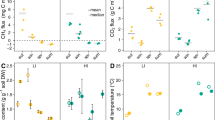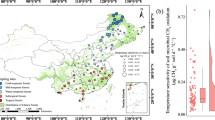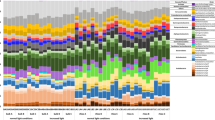Abstract
Microbial oxidation is the only biological sink for atmospheric methane. We assessed seasonal changes in atmospheric methane oxidation and the underlying methanotrophic communities in grassland near Giessen (Germany), along a soil moisture gradient. Soil samples were taken from the surface layer (0–10 cm) of three sites in August 2007, November 2007, February 2008 and May 2008. The sites showed seasonal differences in hydrological parameters. Net uptake rates varied seasonally between 0 and 70 μg CH4 m−2 h−1. Greatest uptake rates coincided with lowest soil moisture in spring and summer. Over all sites and seasons, the methanotrophic communities were dominated by uncultivated methanotrophs. These formed a monophyletic cluster defined by the RA14, MHP and JR1 clades, referred to as upland soil cluster alphaproteobacteria (USCα)-like group. The copy numbers of pmoA genes ranged between 3.8 × 105–1.9 × 106 copies g−1 of soil. Temperature was positively correlated with CH4 uptake rates (P<0.001), but had no effect on methanotrophic population dynamics. The soil moisture was negatively correlated with CH4 uptake rates (P<0.001), but showed a positive correlation with changes in USCα-like diversity (P<0.001) and pmoA gene abundance (P<0.05). These were greatest at low net CH4 uptake rates during winter times and coincided with an overall increase in bacterial 16S rRNA gene abundances (P<0.05). Taken together, soil moisture had a significant but opposed effect on CH4 uptake rates and methanotrophic population dynamics, the latter being increasingly stimulated by soil moisture contents >50 vol% and primarily related to members of the MHP clade.
Similar content being viewed by others
Log in or create a free account to read this content
Gain free access to this article, as well as selected content from this journal and more on nature.com
or
References
Baani M, Liesack W . (2008). Two isozymes of particulate methane monooxygenase with different methane oxidation kinetics are found in Methylocystis sp. strain SC2. Proc Natl Acad Sci USA 105: 10203–10208.
Bárcena TG, Finster KW, Yde JC . (2011). Spatial patterns of soil development, methane oxidation, and methanotrophic diversity along a receding glacier forefield, Southeast Greenland. Arct Antarct Alp Res 43: 178–188.
Belova SE, Baani M, Suzina NE, Bodelier PLE, Liesack W, Dedysh SN . (2011). Acetate utilization as a survival strategy of peat-inhabiting Methylocystis spp. Environ Microbiol Rep 3: 36–46.
Blunier T, Chappellaz J, Schwander J, Barnola JM, Desperts T, Stauffer B et al. (1993). Atmospheric methane record from a Greenland ice core over the last 1000 years. Geophys Res Lett 20: 2219–2222.
Bodelier PLE, Laanbroek HJ . (2004). Nitrogen as a regulatory factor of methane oxidation in soils and sediments. FEMS Microbiol Ecol 47: 265–277.
Borken W, Brumme R, Xu YJ . (2000). Effects of prolonged soil drought on CH4 oxidation in a temperate spruce forest. J Geophys Res 105: 7079–7088.
Bourne DG, McDonald IR, Murrell JC . (2001). Comparison of pmoA PCR primer sets as tools for investigating methanotroph diversity in three Danish soils. Appl Environ Microbiol 67: 3802–3809.
Bull ID, Parekh NR, Hall GH, Ineson P, Evershed RP . (2000). Detection and classification of atmospheric methane oxidizing bacteria in soil. Nature 405: 175–178.
Castro MS, Peterjohn WT, Melillo JM, Steudler PA, Gholz HL, Lewis D . (1994). Effects of nitrogen fertilization on the fluxes of N2O, CH4, and CO2 from soils in a Florida slash pine plantation. Can J For Res 24: 9–13.
Cavagnaro TR, Jackson LE, Scow TM, Hristova KR . (2007). Effects of arbuscular mycorrhizas on ammonia oxidizing bacteria in an organic farm soil. Microb Ecol 54: 618–626.
Chen Y, Dumont MG, McNamara NP, Chamberlain PM, Bodrossy L, Stralis-Pavese N et al. (2008). Diversity of the active methanotrophic community in acidic peatlands as assessed by mRNA and SIP-PLFA analyses. Environ Microbiol 10: 446–459.
Conrad R . (2009). The global methane cycle: recent advances in understanding the microbial processes involved. Environ Microbiol Rep 1: 285–292.
Degelmann DM, Borken W, Drake HL, Kolb S . (2010). Different atmospheric methane-oxidizing communities in European beech and Norway spruce soils. Appl Environ Microbiol 76: 3228–3235.
Delmont TO, Robe P, Cecillon S, Clark IM, Constancias F, Simonet P et al. (2011). Accessing the soil metagenome for studies of microbial diversity. Appl Environ Microbiol 77: 1315–1324.
Dörr H, Katruff L, Levin I . (1993). Soil texture parameterization of the methane uptake in aerated soils. Chemosphere 26: 697–713.
Dörr N, Glaser B, Kolb S . (2010). Methanotrophic communities in Brazilian ferralsols from naturally forested, afforested, and agricultural sites. Appl Environ Microbiol 76: 1307–1310.
Dunfield PF . (2007). The soil methane sink. In: Reay D, Hewitt N, Smith K, Grace J (eds). Greenhouse Gas Sinks. CABI Publishing: Wallingford, UK, pp 152–170.
Dunfield PF, Belova SE, Vorob’ev AV, Cornish SL, Dedysh SN . (2010). Methylocapsa aurea sp. nov., a facultative methanotroph possessing a particulate methane monooxygenase, and emended description of the genus Methylocapsa. Int J Syst Evol Microbiol 60: 2659–2664.
Eller G, Frenzel P . (2001). Changes in activity and community structure of methane-oxidizing bacteria over the growth period of rice. Appl Environ Microbiol 67: 2395–2403.
Henckel T, Jäckel U, Schnell S, Conrad R . (2000). Molecular analyses of novel methanotrophic communities in forest soil that oxidize atmospheric methane. Appl Environ Microbiol 66: 1801–1808.
Ho A, Lüke C, Frenzel P . (2011). Recovery of methanotrophs from disturbance: population dynamics, evenness and functioning. ISME J 5: 750–758.
Holmes AJ, Roslev P, McDonald IR, Iversen N, Henriksen K, Murrell JC . (1999). Characterization of methanotrophic bacterial populations in soils showing atmospheric methane uptake. Appl Environ Microbiol 65: 3312–3318.
Horz HP, Raghubanshi AS, Heyer E, Kammann C, Conrad R, Dunfield PF . (2002). Activity and community structure of methane-oxidising bacteria in a wet meadow soil. FEMS Microbiol Ecol 41: 247–257.
Horz HP, Rich V, Avrahami S, Bohannan BJM . (2005). Methane-oxidizing bacteria in a California upland grassland soil: diversity and response to simulated global change. Appl Environ Microbiol 71: 2642–2652.
Hutchinson GL, Mosier AR . (1981). Improved soil cover method for field measurement of nitrous oxide fluxes. Soil Sci Soc Am J 45: 311–316.
Im J, Lee S-W, Yoon S, DiSpirito AA, Semrau JD . (2011). Characterization of a novel facultative Methylocystis species capable of growth on methane, acetate and ethanol. Environ Microbiol Rep 3: 174–181.
IPCC (2007). Climate change 2007: the physical science basis. In: Solomon S, Qin D, Manning M, Chen Z, Marquis M, Averyt KB, Tignor M, Miller HL (eds). Contribution of Working Group I to the Fourth Assessment Report of the Intergovernmental Panel on Climate Change. Cambridge University Press: Cambridge, UK and New York, NY, USA.
Jaatinen K, Knief C, Dunfield PF, Yrjälä K, Fritze H . (2004). Methanotrophic bacteria in boreal forest soil after fire. FEMS Microbiol Ecol 50: 195–202.
Jäger HJ, Schmidt SW, Kammann C, Grünhage L, Müller C, Hanewald K . (2003). The University of Giessen free-air carbon dioxide enrichment study: description of the experimental site and of a new enrichment system. J Appl Bot 77: 117–127.
Kammann C, Grünhage L, Jäger H-J . (2001a). A new sampling technique to monitor concentrations of CH4, N2O and CO2 in air at well-defined depths in soils with varied water potential. Eur J Soil Sci 52: 297–303.
Kammann C, Grünhage L, Jäger HJ, Wachinger G . (2001b). Methane fluxes from differentially managed grassland study plots: the important role of CH4 oxidation in grassland with a high potential for CH4 production. Environ Pollut 115: 261–273.
Kammann C, Hepp S, Lenhart K, Müller C . (2009). Stimulation of methane consumption by endogenous CH4 production in aerobic grassland soil. Soil Biol Biochem 41: 622–629.
Kammann C, Müller C, Grünhage L, Jäger HJ . (2008). Elevated CO2 stimulates N2O emissions in permanent grassland. Soil Biol Biochem 40: 2194–2205.
Knief C, Dunfield PF . (2005). Response and adaptation of different methanotrophic bacteria to low methane mixing ratios. Environ Microbiol 7: 1307–1317.
Knief C, Kolb S, Bodelier PLE, Lipski A, Dunfield PF . (2006). The active methanotrophic community in hydromorphic soils changes in response to changing methane concentration. Environ Microbiol 8: 321–333.
Knief C, Lipski A, Dunfield PF . (2003). Diversity and activity of methanotrophic bacteria in different upland soils. Appl Environ Microbiol 69: 6703–6714.
Kolb S . (2009). The quest for atmospheric methane oxidizers in forest soils. Environ Microbiol Rep 1: 336–346.
Krause S, Lüke C, Frenzel P . (2010). Succession of methanotrophs in oxygen–methane counter-gradients of flooded rice paddies. ISME J 4: 1603–1607.
Ludwig W, Strunk O, Westram R, Richter L, Meier H, Yadhukumar et al. (2004). ARB: a software environment for sequence data. Nucl Acids Res 32: 1363–1371.
Ogram A, Castro H, Stanley E, Chen W, Prenger J . (2006). Distribution of methanotrophs in managed and highly disturbed watersheds. Ecol Indicat 6: 631–643.
Oksanen J . (2008). Multivariate analysis of ecological communities in R: vegan tutorial. [WWW document]. URL http://cc.oulu.fi/~jarioksa/opetus/metodi/vegantutor.pdf. 2-13-2008. Ref Type: Internet Communication.
Regan K, Kammann C, Hartung K, Lenhart K, Müller C, Philippot L et al. (2011). Can differences in microbial abundances help explain enhanced N2O emissions in a permanent grassland under elevated atmospheric CO2? Global Change Biol 17: 3176–3186.
Shrestha M, Abraham WR, Shrestha PM, Noll M, Conrad R . (2008). Activity and composition of methanotrophic bacterial communities in planted rice soil studied by flux measurements, analyses of pmoA gene and stable isotope probing of phospholipid fatty acids. Environ Microbiol 10: 400–412.
Shrestha M, Shrestha PM, Frenzel P, Conrad R . (2010). Effect of nitrogen fertilization on methane oxidation, abundance, community structure, and gene expression of methanotrophs in the rice rhizosphere. ISME J 4: 1545–1556.
Shrestha PM, Noll M, Liesack W . (2007). Phylogenetic identity, growth-response time and rRNA operon copy number of soil bacteria indicate different stages of community succession. Environ Microbiol 9: 2464–2474.
Singh BK, Tate KR, Kolipaka G, Hedley CB, Macdonald CA, Millard P et al. (2007). Effect of afforestation and reforestation of pastures on the activity and population dynamics of methanotrophic bacteria. Appl Environ Microbiol 73: 5153–5161.
Torn MS, Harte J . (1996). Methane consumption by Montane soils: implications for positive and negative feedback with climatic change. Biogeochemistry 32: 53–67.
Wang JS, Logan JA, McElroy MB, Duncan BN, Megretskaia IA, Yantosca RM . (2004). A 3-D model analysis of the slowdown and interannual variability in the methane growth rate from 1988 to 1997. Global Biogeochem Cycles 18: B3011.
Wuebbles DJ, Hayhoe K . (2002). Atmospheric methane and global change. Earth-Sci Rev 57: 177–210.
Acknowledgements
The study was supported by the European Science Foundation (METHECO, EuroDiversity 018) and Deutsche Forschungsgemeinschaft (LI 455/3-1). Additional support was provided by the LOEWE Center for Synthetic Microbiology (SYNMIKRO). Bomba Dam is a recipient of an Alexander von Humboldt Fellowship. Claudia Kammann gratefully acknowledges a postdoctoral fellowship of the University College Dublin.
Author information
Authors and Affiliations
Corresponding author
Additional information
Supplementary Information accompanies the paper on The ISME Journal website
Supplementary information
Rights and permissions
About this article
Cite this article
Shrestha, P., Kammann, C., Lenhart, K. et al. Linking activity, composition and seasonal dynamics of atmospheric methane oxidizers in a meadow soil. ISME J 6, 1115–1126 (2012). https://doi.org/10.1038/ismej.2011.179
Received:
Revised:
Accepted:
Published:
Issue date:
DOI: https://doi.org/10.1038/ismej.2011.179
Keywords
This article is cited by
-
The methane-driven interaction network in terrestrial methane hotspots
Environmental Microbiome (2022)
-
Unique high Arctic methane metabolizing community revealed through in situ 13CH4-DNA-SIP enrichment in concert with genome binning
Scientific Reports (2022)
-
Greenhouse gas (CO2, CH4, and N2O) emissions after abandonment of agriculture
Biology and Fertility of Soils (2022)
-
Aerobic Methanotrophy and Co-occurrence Networks of a Tropical Rainforest and Oil Palm Plantations in Malaysia
Microbial Ecology (2022)
-
Nitrogen addition decreases methane uptake caused by methanotroph and methanogen imbalances in a Moso bamboo forest
Scientific Reports (2021)



